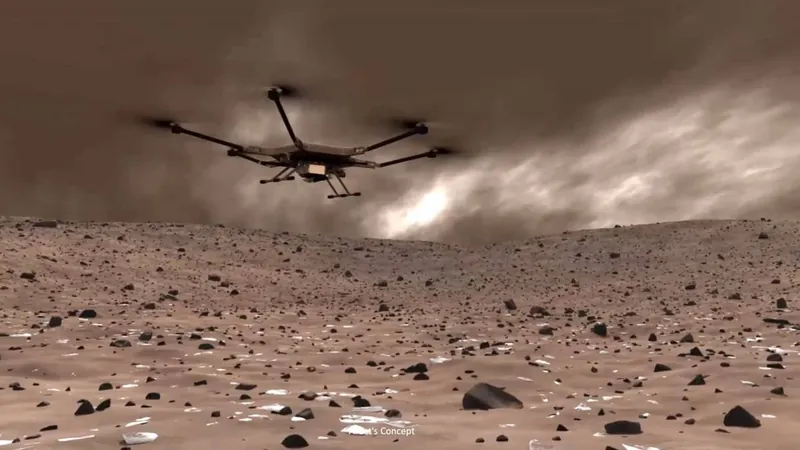
Meet 'Nighthawk': NASA's Next Generation Mars Helicopter Could Transform Space Exploration!
2025-04-05
Author: Wei
Introduction
NASA's pioneering Ingenuity drone has made remarkable strides in Mars exploration, demonstrating that helicopters have the potential to revolutionize our understanding of the Red Planet. Building on this groundbreaking success, NASA is now focused on expanding its ambitions with the development of a larger and more advanced drone dubbed 'Mars Chopper.'
The Nighthawk Mission
This formidable spacecraft, comparable in size to an SUV, will be equipped with six rotors, each featuring six blades to facilitate flight in Mars' thin atmosphere. The concept and capabilities of the Mars Chopper were showcased during the recent Lunar and Planetary Science Conference in Texas, where an exciting proposal known as Nighthawk was introduced.
Nighthawk is set to undertake adventurous missions autonomously, without relying on a rover for support, unlike its predecessor Ingenuity, which needed the Perseverance rover for operations. This new helicopter aims to explore the rugged terrain of Eastern Noctis Labyrinthus—a scientifically rich region at the intersection of the Valles Marineris canyon system and the vast Tharsis volcanic plateau.
Scientific Significance
This area is particularly intriguing due to its potential for hosting biomarkers and its relevance for future human exploration. Notably, Noctis Landing, located in this region, is being considered as a possible site for future crewed missions, making it a priority for investigation.
The Nighthawk mission aims to conduct in-depth studies of water and volcanic features, tracing their evolution and history. It will specifically investigate Noctis Volcano, a colossal and deeply eroded structure that is expected to contain significant amounts of glacier ice—essential for understanding Mars' climate history and preparing for potential human habitation.
Advanced Technology
Equipped with innovative science payloads that total just 6.6 pounds (3.0 kilograms) of the available 11 lbs (5 kg) capacity on Mars Chopper, Nighthawk will be able to ascend to impressive altitudes of 4,920 feet (1,500 meters) above the Martian surface. This operational height is remarkably higher than Ingenuity's flights, which occurred roughly 1.6 miles (2.6 kilometers) below the global average altitude.
Nighthawk's cutting-edge instruments include OCCAM (Omni-directional Color CAMera system), an eight-camera color imaging system designed for navigation and geological analysis; the NIRAC spectrometer and context camera for enhanced imaging capabilities; and PMWS (Puli Mars Water Snooper), a specialized neutron detector to evaluate water abundance below the surface.
Mission Objectives
The proposed mission envisions Nighthawk operating for at least 240 sols (Mars days) and conducting up to 100 flights, each covering distances of approximately 1.86 miles (3.0 kilometers). According to the mission team, led by Pascal Lee from NASA's Ames Research Center, "Nighthawk's science mission would not be feasible with an Ingenuity-class helicopter, but is within reach for the more advanced NASA Mars Chopper now in the works."
Conclusion
Robert Maurer, a NASA program manager, expressed his excitement: "The vision for Mars Chopper and Nighthawk represents a bold step forward in how we explore distant worlds. The scientific discoveries that lie ahead could reshape our understanding of Mars and open new doors for human exploration."
While there's currently no timeline for when NASA will choose missions based on the Mars Chopper proposal, the prospect of Nighthawk is certainly a captivating glimpse into an exciting future of extraterrestrial exploration! Will this be the key to unlocking Mars' secrets and paving the way for a future human presence? Stay tuned!


 Brasil (PT)
Brasil (PT)
 Canada (EN)
Canada (EN)
 Chile (ES)
Chile (ES)
 Česko (CS)
Česko (CS)
 대한민국 (KO)
대한민국 (KO)
 España (ES)
España (ES)
 France (FR)
France (FR)
 Hong Kong (EN)
Hong Kong (EN)
 Italia (IT)
Italia (IT)
 日本 (JA)
日本 (JA)
 Magyarország (HU)
Magyarország (HU)
 Norge (NO)
Norge (NO)
 Polska (PL)
Polska (PL)
 Schweiz (DE)
Schweiz (DE)
 Singapore (EN)
Singapore (EN)
 Sverige (SV)
Sverige (SV)
 Suomi (FI)
Suomi (FI)
 Türkiye (TR)
Türkiye (TR)
 الإمارات العربية المتحدة (AR)
الإمارات العربية المتحدة (AR)